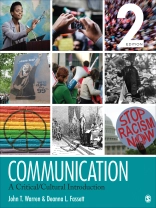This exciting text for the hybrid course introduces communication theory, interpersonal communication, and public communication and culture through the lens of contemporary critical theory. The book focuses on public advocacy as a more meaningful way to approach public speaking through coverage of topics and issues that students are most passionate about. By situating communication concepts and theories within contemporary and engaging cultural scenes, the book is much more than a survey of ideas—it demonstrates the power of communication in our everyday lives.
Tabela de Conteúdo
Preface
Part I: First Principles
1. Communication: A Cultural Introduction
2. Communication and Power: A Cultural History
3. Public Advocacy: Commitments and Responsibility
Part II: Communication Processes and Skills
4. Compassionate Critical Listening
5. Groups and Alliances in Culture
6. Identity and Perception
7. Language and Culture
Part III: Communication Contexts
8. Embodied Knowledge and Non-Verbal Communication
9. Language and Power in Our Cultural Lives
10. Interpersonal Relationships in Culture
11. Mediated Culture(s)
12. Communication as a Means of Social Action
Glossary
Index
About the Authors
Sobre o autor
Deanna L. Fassett is Department Chair and professor of communication pedagogy at San José State University where she has, since 2002, mentored her department’s graduate student instructors. She is the author and editor of three other books: Coordinating the Communication Course: A Guidebook, Critical Communication Pedagogy, The SAGE Handbook of Communication and Instruction, and Communication: A Critical/Cultural Introduction, Second Edition. Her published research has appeared in a broad array of communication studies journals, including Basic Communication Course Annual, Communication Education, Liminalities: A Journal of Performance Studies, and Text and Performance Quarterly.












